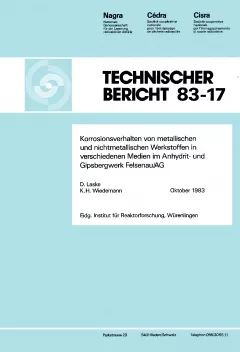
Technischer Bericht NTB 83-17
Korrosionsverhalten von metallischen und nichtmetallischen Werkstoffen in verschiedenen Medien im Anhydrit- und Gipsbergwerk Felsenau/AG
Organic components in an intermediate level waste repository decompose under both aerobic and anaerobic conditions to produce carbon dioxide, which may lead to acid corrosion of metallic containers and hence to hydrogen production.
The possibility of hydrogen production within the repository must be considered in determining the long term safety.
Thermodynamic calculations show that only pure water is required to produce hydrogen with iron in a repository. The hydrogen evolution rate is thus the important parameter. However, the available kinetic data is insufficient and needs to be supplemented experimentally.
Carbon steel specimens were immersed in water over which several gas mixtures containing nitrogen, oxygen and carbon dioxide were passed; the amount of hydrogen picked up by the gas stream was measured.
1.4 - 28 ml hydrogen per square meter per hour was evolved when the gas mixture contained 1 and 20 volume per cent carbon dioxide respectively. Hydrogen was also detected in natural CO2-free water when oxygen concentration cells are present. No hydrogen could be detected at pH 8.5 and above.
The experiments were all carried out at 25°C and atmospheric pressure and restricted to the carbonate system. Natural waters contain a mixture of salts; this may increase or reduce the hydrogen evolution rate. Higher temperatures and pressures, in particular a higher partial pressure of carbon dioxide, will probably lead to an increase in the hydrogen evolution rate.
